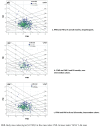Small-quantity lipid-based nutrient supplements, with or without added zinc, do not cause excessive fat deposition in Burkinabe children: results from a cluster-randomized community trial
- PMID: 35829783
- PMCID: PMC9596589
- DOI: 10.1007/s00394-022-02936-6
Small-quantity lipid-based nutrient supplements, with or without added zinc, do not cause excessive fat deposition in Burkinabe children: results from a cluster-randomized community trial
Abstract
Purpose: Public health interventions to address stunting and wasting should be evaluated for possibly contributing to obesity risk. The present study tested the hypothesis that small-quantity lipid-based nutrient supplements (SQ-LNS) might increase fat deposition, and that additional zinc provided via SQ-LNS or in the form of dispersible tablets would increase fat-free mass (FFM) accretion.
Methods: Using a two-stage, cluster-randomized trial design, 34 communities were randomly assigned to the intervention cohort (IC) or non-intervention cohort (NIC), and family compounds within the IC were randomly assigned to receive different amounts of zinc (0, 5 or 10 mg zinc) incorporated in SQ-LNS or 5 mg zinc in the form of dispersible tablets along with treatment for diarrhea, malaria and fever. Body composition was assessed in a subset of IC (n = 201) and NIC (n = 74) children at 9 and 18 months using the deuterium dilution method. A mixed linear model was used to examine average change in FFM and % fat mass (%FM) among intervention groups and by cohort.
Results: Children in the IC had significantly greater change in FFM (Mean (95% Confidence Interval)) (1.57 (1.49, 1.64) kg) compared to the NIC (1.35 (1.23, 1.46) kg; p = 0.005). There were no significant differences in the change in %FM between the NIC and IC or among the intervention groups.
Conclusion: SQ-LNS, along with morbidity treatment increased weight gain and FFM in young children from 9 to 18 months of age without increasing FM deposition. Additional zinc supplementation did not affect changes in FFM or %FM.
Trial registration: The study was registered as a clinical trial with the US National Institute of Health ( www.
Clinicaltrials: gov ; NCT00944281).
Keywords: Body composition; Child; Deuterium dilution technique; Fat mass; Fat-free mass; Small-quantity lipid-based nutrient supplements; Zinc.
© 2022. The Author(s).
Conflict of interest statement
KHB, the spouse of SYH, worked for the Bill & Melinda Gates Foundation. None of the other authors have a conflict of interest to declare.
Figures
References
-
- WHO/UNICEF (2009) WHO child growth standards and the identification of severe acute malnutrition in infants and children: a joint statement by the World Health Organization and the United Nations Children’s Fund - PubMed
-
- Black RE, Victora CG, Walker SP, Bhutta ZA, Christian P, de Onis M, Ezzati M, Grantham-McGregor S, Katz J, Martorell R, et al. Maternal and child undernutrition and overweight in low-income and middle-income countries. Lancet. 2013;382(9890):427–451. doi: 10.1016/S0140-6736(13)60937-X. - DOI - PubMed
-
- Abarca-Gómez L, Abdeen ZA, Hamid ZA, Abu-Rmeileh NM, Acosta-Cazares B, Acuin C, Adams RJ, Aekplakorn W, Afsana K, Aguilar-Salinas CA, et al. Worldwide trends in body-mass index, underweight, overweight, and obesity from 1975 to 2016: a pooled analysis of 2416 population-based measurement studies in 1289 million children, adolescents, and adults. The Lancet. 2017 doi: 10.1016/S0140-6736(17)32129-3. - DOI - PMC - PubMed
-
- Food and Agriculture Organization of the United Nations (FAO), International Fund for Agricultural Development (IFAD), the United Nations Children’s Fund (UNICEF), World Food Programme (WFP), World Health Organization (WHO) (2017) The state of food security and nutrition in the world 2017: building resilience for peace and food security



